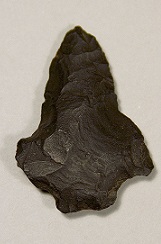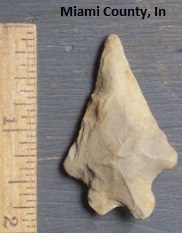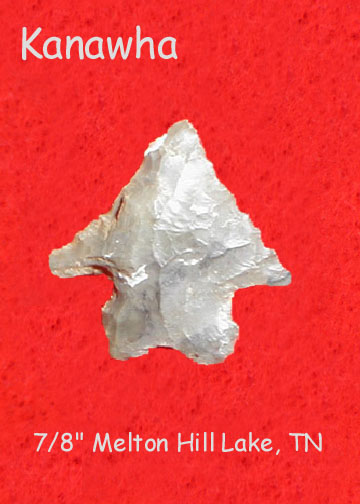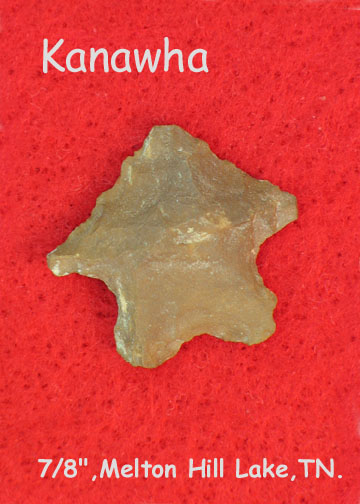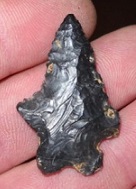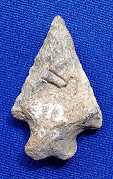Outline is Representative of Size and Shape:

Name Details:
Identified By: Bettye J. Broyles
Named For: County in West Virginia
Date Identified: 1971
Type Site: St. Albans Site, Kanawha County, West Virginia
Identified By: Bettye J. Broyles
Named For: County in West Virginia
Date Identified: 1971
Type Site: St. Albans Site, Kanawha County, West Virginia
Point Validity:
Valid type
Broyles is a distinguished anthropologist who was a professor at many prestigious universities. She is most known for her excavations at St. Albans Site in West Virginia. This type was named in a professional publication and has many professional references. This is a valid type.
Kanawha Bifurcated
Cluster: LeCroy Cluster Description of Physical Characteristics and Flaking Pattern:
This is a small to medium triangular bifurcated point with an elliptical cross section. The cross section may range from thin to thick. The blade is primarily straight, but may be incurvate or recurvate on heavily re-sharpened examples. On heavily re-sharpened examples the shoulders edge may have a strong flare. The blade is commonly serrated. The shoulders are sloped upwards. The stem is expanding with a bifurcated base. Basal thinning is common, but basal grinding is not present. This point has a random flaking pattern.
Size Measurements:
Total Length - 19 to 48 mm (average 30 to 36 mm), Stem Length - 4 to 7 mm, Blade Width - 19 to 37 mm, Neck Width - 8 to 14 mm, Stem Width - 10 to 15 mm, Thickness - 3 to 7 mm
Total Length - 19 to 48 mm (average 30 to 36 mm), Stem Length - 4 to 7 mm, Blade Width - 19 to 37 mm, Neck Width - 8 to 14 mm, Stem Width - 10 to 15 mm, Thickness - 3 to 7 mm
Commonly Utilized Material:
Additional Comments:
This point is thought to have evolved into the large Stanly Stemmed point (Coe, 1964).
This point has been dated to the Early Archaic period, however, Garner (1989) argues that the introduction of the bifurcated base is the beginning of the Middle Archaic period.
At the St. Albans site, this point was found in levels above the LeCroy levels and below the Stanly levels (W10).
Funk (1993) states that bifurcated bases were used in the north for periods long after this base was abandoned in the south.
This point is thought to have evolved into the large Stanly Stemmed point (Coe, 1964).
This point has been dated to the Early Archaic period, however, Garner (1989) argues that the introduction of the bifurcated base is the beginning of the Middle Archaic period.
At the St. Albans site, this point was found in levels above the LeCroy levels and below the Stanly levels (W10).
Funk (1993) states that bifurcated bases were used in the north for periods long after this base was abandoned in the south.
Distribution: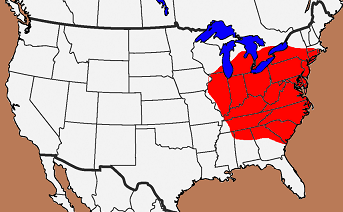

Distribution Comments:
These points are primarily associated with the Ohio River Valley and into the seaboard region and Northeastern region. This point may be found into the Tennessee River Valley and Georgia with decreased frequency.
These points are primarily associated with the Ohio River Valley and into the seaboard region and Northeastern region. This point may be found into the Tennessee River Valley and Georgia with decreased frequency.
Age / Periods:
Date: 8,200 - 7,800 B.P.
Cultural Period: Early Archaic
Glacial Period: Middle Holocene
Culture:
Phase:
Date: 8,200 - 7,800 B.P.
Cultural Period: Early Archaic
Glacial Period: Middle Holocene
Culture:
Phase:
Age Details:
The Kanawha Stemmed type was found in zones two and four (1 to 3 feet below surface) which have a radiocarbon date of 6210 B.C. ± 100 years (Harter, 1973).
The Kanawha Stemmed type was found in zones two and four (1 to 3 feet below surface) which have a radiocarbon date of 6210 B.C. ± 100 years (Harter, 1973).

